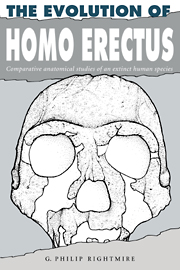Book contents
- Frontmatter
- Contents
- Preface
- 1 Introduction
- 2 Homo erectus in the Far East
- 3 Homo erectus at Olduvai Gorge
- 4 Discoveries from the Turkana basin and other localities in sub-Saharan Africa
- 5 Northwest Africa
- 6 Comparisons of African hominids with Asian Homo erectus
- 7 Homo erectus as a paleospecies
- 8 The transition to more modern forms
- 9 Summary and prospects for further research
- References
- Author index
- Subject index
3 - Homo erectus at Olduvai Gorge
Published online by Cambridge University Press: 14 October 2009
- Frontmatter
- Contents
- Preface
- 1 Introduction
- 2 Homo erectus in the Far East
- 3 Homo erectus at Olduvai Gorge
- 4 Discoveries from the Turkana basin and other localities in sub-Saharan Africa
- 5 Northwest Africa
- 6 Comparisons of African hominids with Asian Homo erectus
- 7 Homo erectus as a paleospecies
- 8 The transition to more modern forms
- 9 Summary and prospects for further research
- References
- Author index
- Subject index
Summary
Olduvai Gorge lies in the Serengeti Plain of northern Tanzania. The importance of the gorge and its fossils was recognized early in the century, and several expeditions carried out paleontological and stratigraphic fieldwork at the site before 1935. In that year, Louis and Mary Leakey spent three months at Olduvai, and shorter visits were made later. However, it was not until 1959 that Zinjanthropus was recovered from the deposits of Bed I. With funding from the National Geographic Society, the Leakeys began systematic excavations in 1960. These were continued until 1963. More intensive investigations followed between 1968 and 1972, and fieldwork has continued intermittently. The number of Olduvai fossil individuals attributed to Australopithecus and Homo now stands at 62.
Stratigraphy and dating of the Olduvai deposits
Deposits at Olduvai are up to 100 m thick and provide a relatively complete stratigraphic record for a period beginning over 2.0 million years ago and extending to the close of the Pleistocene. Early work undertaken by Hans Reck established that the sedimentary sequence overlying basaltic lavas at the bottom of the gorge could be divided into a series of units, of which Bed I is the oldest. Bed I is the thickest of the major subdivisions, consisting of lava flows and deposits associated with a shallow lake. This bed is well-dated and has yielded some of the most famous hominids, including Zinjanthropus and remains of Homo habilis.
- Type
- Chapter
- Information
- The Evolution of Homo ErectusComparative Anatomical Studies of an Extinct Human Species, pp. 57 - 85Publisher: Cambridge University PressPrint publication year: 1990

